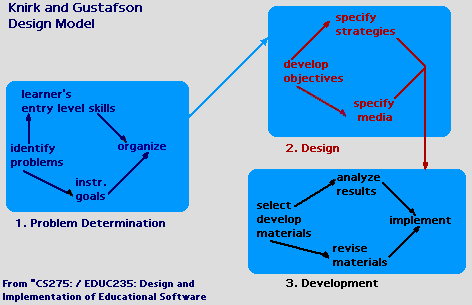Knirk and Gustafson design model: Difference between revisions
Jump to navigation
Jump to search
(using an external editor) |
(using an external editor) |
||
| Line 2: | Line 2: | ||
== Definition == | == Definition == | ||
The Knirk and Gustafons design method and model is prescriptive stage model for instructional designers. | |||
[[Image: Knirk-gustavson-design-model.gif]] | [[Image: Knirk-gustavson-design-model.gif]] | ||
== The Model == | |||
Knirk and Gustafson (1986) designed three stage process which includes problem determination, design and development. | |||
# The problem determination stage includes identification of the problem, definition of the pedagogical goals and identification of what the learners can do (knowledge, skills, learning styles, affect, etc.) | |||
# The design stage includes developing objectives and specifying strategies. | |||
# The development stage includes development of materials, testing and revision. | |||
== Links == | |||
* http://ed.isu.edu/isdmodels/Knirk/Knirk.html | |||
* http://lts.ncsu.edu/guides/instructional_design/selecting_models2.htm | |||
== References == | == References == | ||
Revision as of 16:04, 19 May 2006
Definition
The Knirk and Gustafons design method and model is prescriptive stage model for instructional designers.
The Model
Knirk and Gustafson (1986) designed three stage process which includes problem determination, design and development.
- The problem determination stage includes identification of the problem, definition of the pedagogical goals and identification of what the learners can do (knowledge, skills, learning styles, affect, etc.)
- The design stage includes developing objectives and specifying strategies.
- The development stage includes development of materials, testing and revision.
Links
- http://ed.isu.edu/isdmodels/Knirk/Knirk.html
- http://lts.ncsu.edu/guides/instructional_design/selecting_models2.htm
